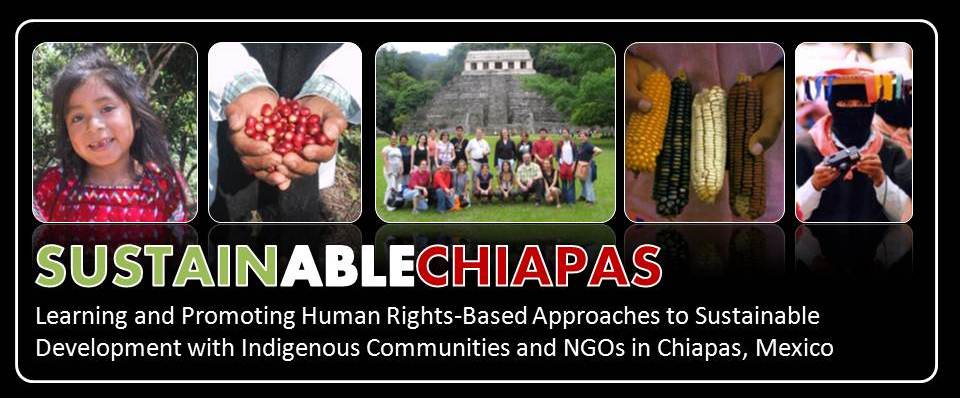
This idea was at first startling to me. The idea that a plant could represent a person or people was very foreign to me. But as I thought further about this concept, I realized how rational it was to associate your identity with your primary source of energy. The murals of Caracol de Oventic revealed that for the Zapatistas, corn had many complex meanings. Their art revealed ideas of solidarity, self-reliance, power, and the importance of anonymity.
The more I embraced this concept of identity, the better I understood the emotional backlash to bioprospecting in Chiapas. In 1999, eleven indigenous community organizations, known as Consejo Estatal de Parteras y M dicos Ind genas Tradicionales de Chiapas (Council of Indigenous Traditional Midwives and Healers of Chiapas), came together to oppose a $2.5 million dollar bioprospecting program initiated by the University of Georgia. The scope of the program was to collect and analyze thousands of medicinal plants from Mayan communities over a period of five years. The primary purpose of the bioprospecting was to isolate compounds from medicinal plants that could be developed for private use by pharmaceutical companies. The method for identifying which of the 6,000 plus plants growing in the region had medicinal purpose, and for which ailments, was entirely dependent on the existing body of Mayan knowledge and the communities’ healers willingness to share it.
The University of Georgia attempted to develop a comprehensive botanical survey of the Central Chiapas Highland in an effort to identify which plants had the greatest potential for generating profit for the university’s commercial partner, Molecular Nature, Ltd., based in the United Kingdom. In response to this project, many local organizations began leveraging the claim that their knowledge and resources were being stolen. The Council called into question the ethical standards of the researchers, who had not received prior consent from local communities before they began collecting hundreds of samples from the mountainside. They also attacked the project’s organizers for trying to skirt the issue of obtaining consent from the indigenous Mayan communities by developing a non-profit organization called PROMAYA (Protection of Mayan Intellectual Property Rights) to advance their political agenda. University of Georgia and Molecular Nature, Inc. essentially created their own civil society organization, PROMAYA, for the sole purpose of obtaining bioprospecting rights from this supposedly indigenous, Mayan organization. After two years of a heavy resistance and intense lobbying of the Mexican and US governments to recognize indigenous communities rights to their own knowledge and resources, the Council was successful. The University of Georgia project was terminated in 2001.
Bioprospecting projects often seek to gain prior consent from communities by offering limited benefits-sharing programs for any plant or organization that produces profit. In the case of Chiapas, the benefits-sharing contracts offered were so miniscule that they only averaged 0.3 to 0.5% of the total profit. Moreover, once a pharmaceutical company isolates a chemical compound from a plant specimen they are able to patent the compound under US Patent Laws. Ironically, only private, for-profit entities are able to able to seek patents for compounds. An indigenous tribe or community, according to patent law, has no legal right to its own local resources.
Understanding the indigenous communities’ connection to the plants that sustain them has caused me to become highly critical of bioprospecting. One of the strongest challenges that the Council made against bioprospecting in Chiapas was that organisms cannot and should not be taken from communities, where they are freely shared, for the purpose of limiting access to only those who are willing and able to pay. Seen from their perspective, I am able to recognize how brutal and alien American culture must seem to communities for whom hunger and disease are a very real aspect of daily life.
As I look at the murals from Caracol de Oventic, I cannot help but think that the smiling faces in the corn share a secret that we in the global north are unwilling to acknowledge. We may come from highly developed nations, but we are no less dependent on the earth and one another for our own survival. Our identities are entwined through the world we inhabit and the resources it provides.
References and Further Reading
“Biopiracy, Bioprospecting, and Resistance: Four Cases in Mexico” by Andres Barreda
The Botany of Desire: A Plant’s-Eye View of the World by Michael Pollan Random House, New York 2001
Etc Group websites:
http://www.etcgroup.org/en/node/348
http://www.etcgroup.org/en/node/232
Rural Advancement Foundation International (RAFI) website http://www.rag.org.au/baa/biopiracy.htm


